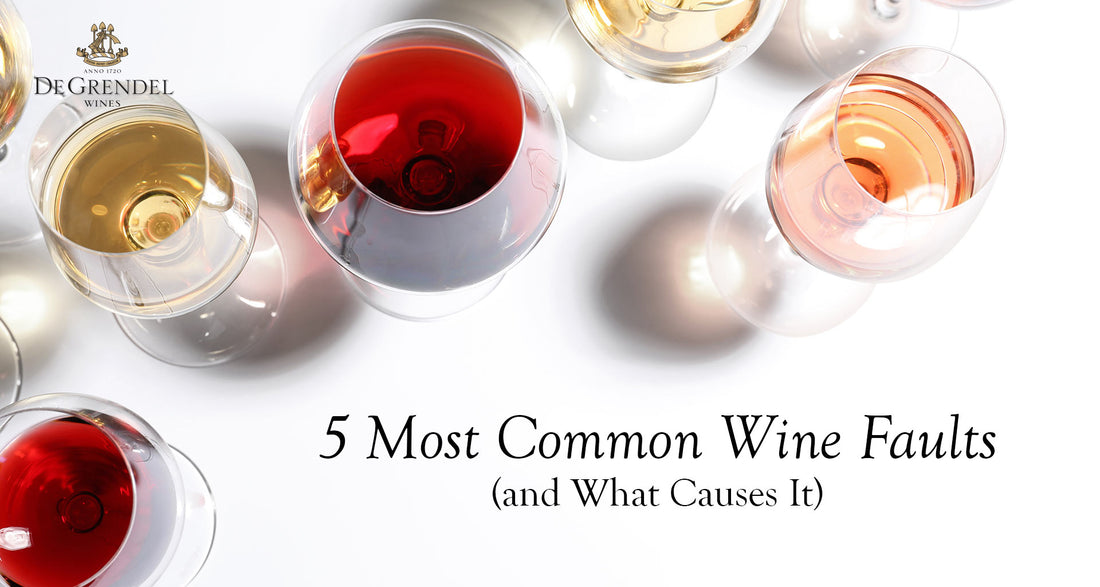
5 Most Common Wine Faults (and What Causes It)
Share
Ever wondered why the waiter pours you a taster when opening a bottle of wine? This is not so you can decide whether you like it or not, but rather to determine any wine faults. We take a closer look at the 5 most common wine faults, what causes it and how to identify it.
Cork Taint (also known as corked wines or Trichloroanisole)
Ever opened a bottle of wine and it smelled like a wet dog, pungent mould, or wet cardboard? Chances are big that your bottle of preciousness has been affected by the fungi present in the cork. The fancy name for those fungi is Trichloroanisole, but colloquially it is referred to as cork taint or a corked wine (which is not a description for a wine closed with a natural cork, that is). The fungi find its way into your wine through several avenues, but the predominant cause is a faulty cork that is already contaminated with TCA. Regrettably, there is nothing you can do to eliminate TCA from a wine, and the best solution is to take it back to the supplier so that they can (hopefully) trace a spoiled batch. Alternatively, buy wines that are closed with screwcaps rather than natural cork. Not only will you get to the romance part of enjoying the wine quicker, but chances are slim that you will open a spoiled wine (and there is no chance of TCA).
Brettanomyces
In short, we call it Brett, and he is not the annoying guy sitting next to you at the dinner party. Brettanomyces is a yeast commonly associated with red wine spoilage, but white wines are not excluded from it. It is usually obvious when Brett is around (much like the annoying guy at the dinner party) as your wine will smell strongly of Band-Aid or Elastoplast. Some refer to it as a ‘hospital’ smell while others call it less pleasant names such a sewage or farmyard. Being a yeast, it can be present in a variety of sources. The winemaker’s job is to track it in the early stages to try and prevent it from spreading. But once inside your bottle of wine, the best thing for the wine is to go down the drain. Brett has a lot to do with high pH and bad cellar hygiene practices. Unless you do not mind small amounts of Brett in your Cabernet, that is. Some people actually like Brett. But only in small doses.

Oxidised wines
Being exposed to oxygen is what will cause a wine to be oxidised. And that is what will cause the wine to lose its shelf life and longevity. This can happen when a natural cork is leaking, which means oxygen will find its way into your wine. Oxidation is another reason why we recommend that a bottle of wine, once opened, gets drunk within two days. Oxidation is evident through a brownish colour in red wines and can be detected on the nose as musty or porty. Young, tight wines will benefit from a little oxygen to soften and open it up, and decanters are beneficial in this regard.
Volatile Acidity
In short, we call it VA. Extremely high levels of acetic acid can cause the wine to smell like vinegar, nail varnish, or paint thinners. VA is often associated with oxidation problems in a wine because both result from overexposure to oxygen and/or a lack of sulphur dioxide management. In 1857, Louis Pasteur set out to determine what was causing beer and wine to spoil. Acetic acid bacteria were the microorganisms that Pasteur eventually identified as the spoilage culprit! VA is, in essence, a winemaking fault and can be caused by several practices. These include prolonged headspace in tank or barrel, excessive barrel ageing, when barrels are not sterilised regularly, and stuck fermentation. If VA is not detected early, the wine will end up tasting and smelling like vinegar.
Secondary fermentation (in a supposedly still wine, that is)
If you have ever opened a still wine (white or red) and the bottle made a fizzy sound, almost like when you open a bottle of soda, then the wine is likely undergoing secondary fermentation in the bottle. This is not to be confused with a wine that has recently been bottled which may also have the tiny, odd bubble present, for instance a very fresh and young Sauvignon Blanc or Rosé may show a few bubbles when being poured. It is because the wine has been bottled with approximately 1300mg CO2 to get rid of all the oxygen in the bottle before being filled with wine.
Essentially, re-fermentations are avoided either by controlling the microorganisms that perform them (yeast or bacteria) or by controlling their food source (sugars in the case of the yeast; malic acid and alcohol in the case of bacteria). Once you pour the wine into a glass, you will see tiny bubbles forming on the sides of the glass, which is an indication of active yeast cells. But let it be known that not all secondary fermentation happens accidentally. Some winemakers do this intentionally, especially on a white wine when making a light frizzante type of wine. If you do not like the bubbles in your wine, decant it slowly so that the bubbles are released. (Just do not perform this on a perfectly good bottle of Cap Classique!) But other than the bubbles’ presence, the wine should be perfectly healthy and fit for human consumption.